#3d graphic accelator
Explore tagged Tumblr posts
Text
Quake 2 – 3,2,1 countdown and up to generator of a black hole
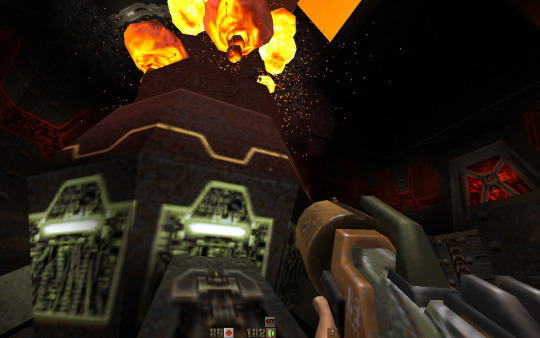
And I continue my summer walkthrough summer, my summer walk in second Quake. From time to time, as a time break, pause, relax. And I, already, solve the reactor moment. Lots of things – I was doing for this. To stop cooler. And next to run different maps and push the buttons. Something to do with water. And, only, after that reactor was destroyed. Of course, it was about very different maps. And different number of enemies. Action is in continue.


Interesting new moment in game. You run to final computer. And only after that, you get to know, it is final step. And you push the button. And now you need to run fast. And it is start countdown. And you need to run to the very start point of the map. It is not far. But it is winding road, it not straight. There are turns, corridors. I think, about with attempt number ten I do it. And I need to remember a way. To experiment. It is a big gun location. I think so, as I remember that right now. Some nearby storylines segments. It was very exciting.
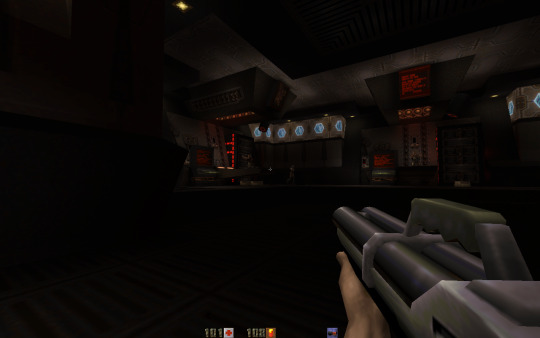
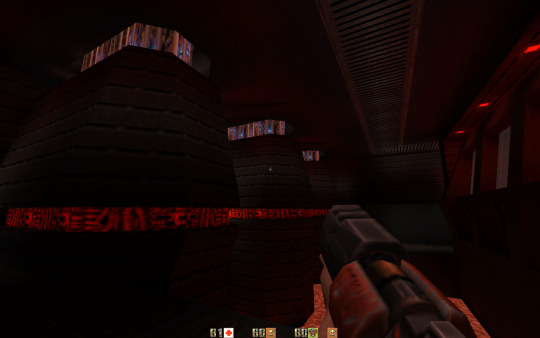
In Quake, there are such short sequences, short briefings. So, it is everything so computerized, as in action movie. So, reactor is done. Big gun is destroyed. Saying more correct, it was something like rocket attack or artillery ride, something like that it was in a storyline. So, when you play for the first time, you are very surprised. And after first walkthrough, when you are doing one more walkthrough, you are already can pay more attention to the details, so it still interest point to play again. At first, it is simple – surprise point. And just pass the stage. To get to know what to do.
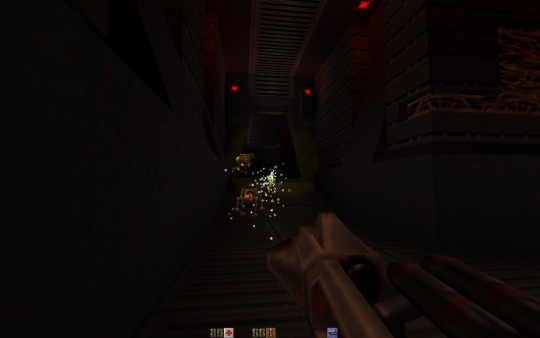
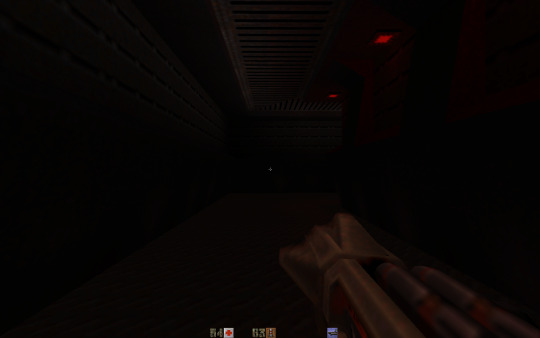
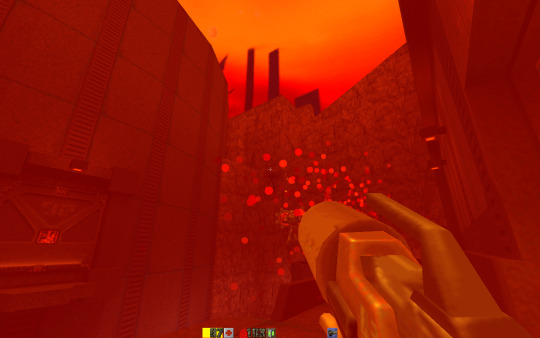
So, I remember a place, when you are in something like mission impossible – and you need to run with time counter back, it was cool! I remember that. Adventure!
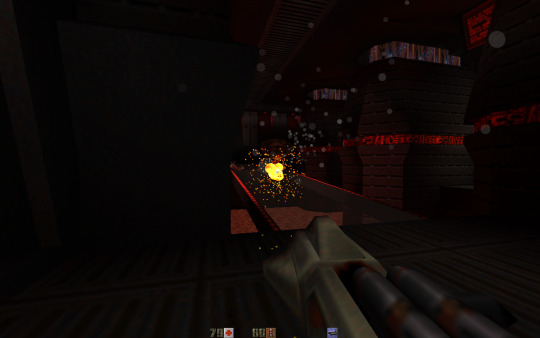
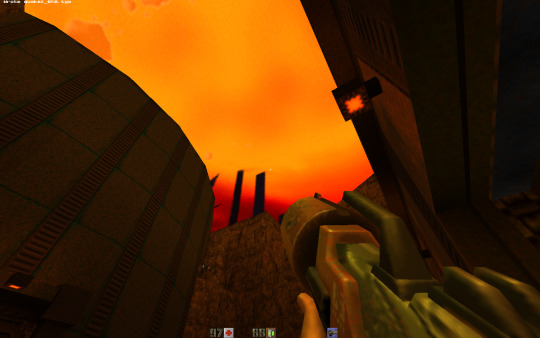
So, one more interesting moment. Near the something black colored and with form like bee hive pillar. Some reactor, maybe it was. It was a lava there. And such a small bridge. It was broken and you go by it. And later you see two computers at the edge. And you need to jump from little bridge to that computer’s small places. One by one to turn them on. Such moment – it is, already, a fragment from style game like Half Life.
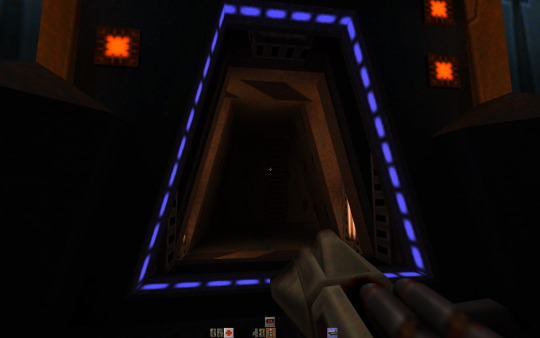
By the way, grenade launcher, of course, it is slow thing, but this thing has some feature. If to hit enemy straight, then explosion is immediately. So, this way it should to be used. Or to throw grenades behind the corner. You see enemy - he is slow. You are doing fast back. And shoot behind the corner with grenade launcher. So, this way it works good.
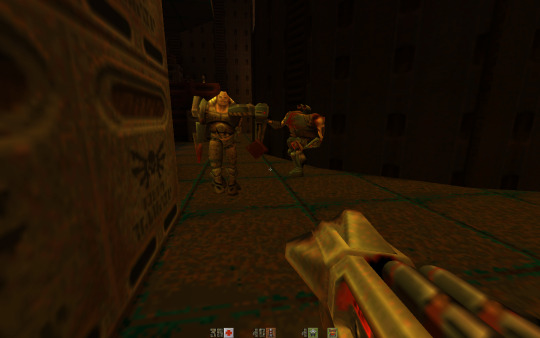
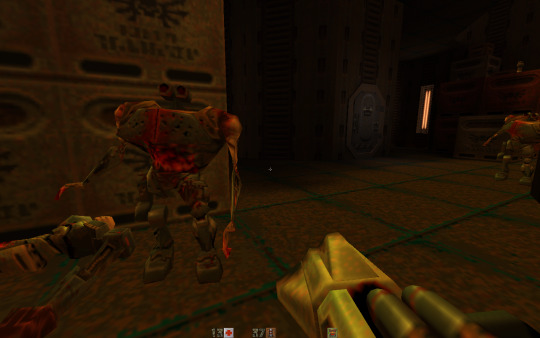
Yes, such a funny moment. In one room, I shoot with rocket launcher. I cannot to hit enemies. They do some move all the time, and move to a different sides. And so, I hit some computer. And it was a secret. I got a message – you find a secret! It was a random thing for me.
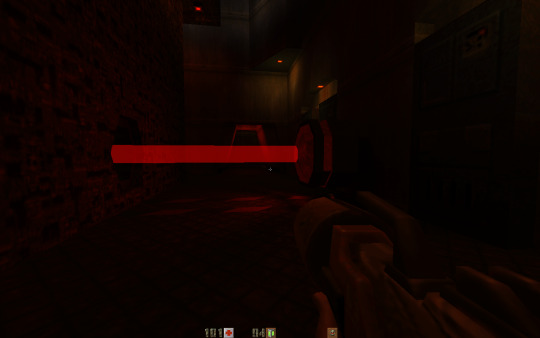
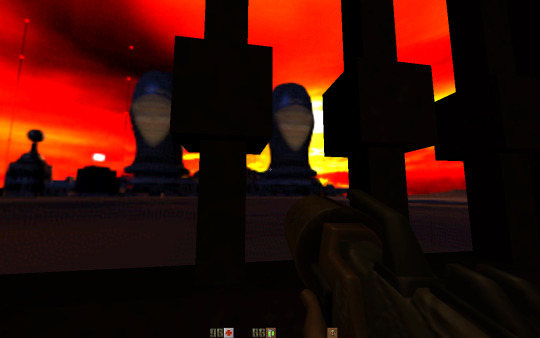
Interesting visual style has a second Quake. It is such from the era of appearing a three dimension graphics. Age of rising three dimensional accelerators for graphics. Everything is such rounded or like squares, it depends from design level. Some special colors, and some smooth effect for textures. Part of textures - it is just like a color, it is stretched to all the wall. Somewhere textures are more detailed, some arts or drawing you can see, even. Smooth, it is a point, that makes a surprise even today. Part of stylization.
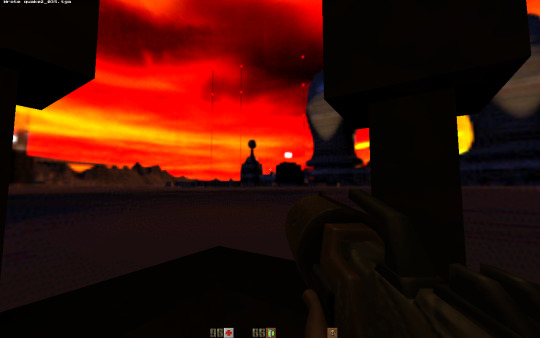
So, there is someway like this, here you have a shotgun, and rocket launcher, rail gun. They have such a circle, rounded forms. It is more often to see. For example. And in some things - it is opposite - a square form. In level design. Explosions are such rectangles style here.
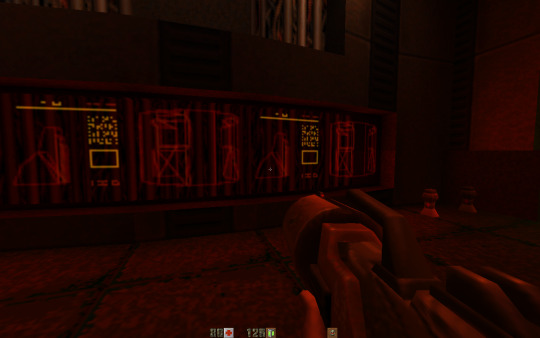
Interesting such action movie. I need to go to hangar. And to destroy a black hole generator. So, not to deactivate it. And certain way to do - destroy it. And, by the way, I find a new enemy on some levels. They are such funny visual rust industrial view robots with green power field. You shoot at them. And it reacts as a bright green shield field. You better to shoot at his legs with something like rockets or grenades. In this case, not from a first attempts, but his shield is breaking. They have a funny visual.
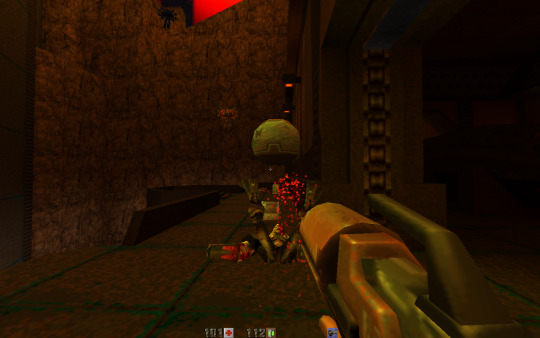
Design, here again, it is, already, like a computer base. So, there are here generators of power field. You need to deactivate them. To run a different maps. To push some buttons at the computers. And, after that to go back to a room with such a dark green computer big thing. And go to a little door. Where before it was a power field.

Playing little games. From time to time i like to play videogames. And write about it. Dima Link is making retro videogames, apps, a little of music, write stories, and some retro more.
WEBSITE: http://www.dimalink.tv-games.ru/home_eng.html ITCHIO: https://dimalink.itch.io/ GAMEJOLT: https://gamejolt.com/@DimaLink/games
BLOGGER: https://dimalinkeng.blogspot.com/
#retro game#retro gaming#pc game#videogames 90s#fps#first person shooter#3d action#quake 2#id software#cyborgs#borgs#future#black hole#generator#robots#alien base#videogames#techno gothic#q2#pc windows#countdown#action movie#run like hell#laser#3dfx#3d graphic accelator#Cool game#shooter
0 notes
Text
Super Famicom - Accele Brid
Title: Accele Brid / アクセルブリッド
Developer: Genki
Publisher: TOMY
Release date: 26 November 1993
Catalogue Code: SHVC-AY
Genre: 3D Rail Shooter


Developed by Genki for Tomy, this very bold attempt at bringing 3D “Polygon” gaming to the SFC without any special processor chips is indeed interesting. The game is a behind-view shooter on rails, meaning that you can’t actually decide where you want to go, only move around the screen on a pre-determined route. But this is fine. There are many good “on rails” games out there such as the Panzer Dragoon series. It’s a shame the same can’t be said about Accele Brid. While the 3D areas are impressive, they’re also very blocky. I have a very strong feeling that the actual size of the 3D areas is pretty small, and they’ve just been zoomed up to a larger size using the SFC’s hardware scaling powers. The reason for this is to keep up speed since the SFC has a very slow processor so doing large 3D areas isn’t going to run smoothly without some sort of co-processor chip in the game cartridge, which this game does not have. Still, even with the blocky look of the 3D graphics it still manages to look ok.
Accele Brid’s main problem is the way it plays. First off, the movement of the mech that you control is pretty sluggish at the best of times not to mention that it gets in the way of oncoming enemies meaning that you can’t always see a projectile or enemy coming towards you. Another annoying feature is the severe lack of ammunition or jumping power. I understand that the limits were implied to give the game more challenge but to be honest quite a lot of the time they just hinder the game rather than making it more challenging in a fun way. Finally, we have the hit detection. This is probably one of the worst points about the game. Trying to line up your weapon’s bullets with oncoming enemies or bosses is a real pain in the arse. Sometimes you’d swear you were right on target, yet the enemy would carry on unscathed while at other times you’d be pretty sure you missed yet hit the enemy target.
It’s a real shame that Accele Brid has sluggish controls and dodgy hit detection because it really does have potential. The whole atmosphere of the game is just like an early 90’s future-style anime, and the music is pretty good in some areas. So, what could have been an excellent game is reduced to a mediocre title thanks to poor controls and dodgy collision detection. Still worth checking out though if you can find the game cheap.

youtube
6 notes
·
View notes
Text
6 Weeks Tableau Training in Noida
Scene versus QlikView: Data Visualization
Colossal Data is impacting!
All together for Big Data to tremendously influence the way in which information is spread and separated, data portrayal accept a gigantic activity. There are various affiliations that believe that its real testing to translate data, and this is really where data discernment acts the legend. It is a customary term that depicts an affiliation's undertakings to empower them to comprehend the significance of data by changing over it into visual substance. There are various basic parts, including precedents and examples that consistently go impalpably in substance based data, yet can be successfully observed with data observation. It in like manner helps digest information as warmth maps and rich graphical portrayals.We should push forward in this Tableau versus QlikView blog and difference these gadgets and the going with parameters:
1. Accommodation
QlikView : It is definitely not hard to use and explore the hid examples. To look, basically type any word in any demand into output box for minute and helpful results and it will show affiliations and associations over your data. It is troublesome for customer to structure their very own points of view due to menu driven properties.

Scene: Its interface is essential, not stacked up with such countless at one page and has a streamlined interface. It doesn't offer feature to look for substance over the whole of your data. Customer can without quite a bit of a stretch make their own one of a kind points of view using distinctive things and it is straightforward because of all around arranged GUI interface.
5. Strategy and System Requirement
QlikView: QlikView has its own special data dispersion focus and alternative of scripting feature expands its estimation. We can use stunned layers in QlikView sending. QlikView is viably pass on able and configurable, and starts making stunning reports near foundation. This thing does not use 3D squares; thusly stacks all of the tables and diagrams in memory to engage natural inquiries and arrangement of reports—an advancement not found in various things. It will in general be made on both 32 and 64 bit. Its subsidiary development makes data showing less demanding.Tableau: It doesn't have its very own data dissemination focus. It can not make layers while partner with educational accumulation. It is progressively less complex to send in light of the fact that it requires continuously sorted out data.
3. Cost
QlikView: Its very own discharge is free with limitation of record sharing. Each named customer license is $1,350 and $15,000 for a synchronous customer. Server license is $35,000/server. Additional $21,000/server for PDF allotment organization; $22,500 for SAP NetWeaver connector.
May require RAM refreshes if far reaching amounts of concurrent customers.
Scene: Free Desktop version called "Open" that makes data is available for all to download. Private structures go with fixed charge $999 or $1,999 depending upon data get to. Scene Server – account evidence says $1000/server customer, with least of 10 customers notwithstanding upkeep.
4. Accessibility with Other instruments/Language or Database
QlikView: It arranges with an incredibly wide extent of data sources like Amazon Vectorwise, EC2, and Redshift, Cloudera Hadoop and Impala, CSV, DatStax, Epicor Scala, EMC Green Plum, Hortonworks Hadoop, HP Vertica, IBM DB2, IBM Netezza, Infor Lawson, Informatica Powercenter, MicroStrategy, MS SQL Server, My SQL, ODBC, Par Accel, Sage 500, Salesforce, SAP, SAP Hana, Teradata, and some more. It can connect with R using API joining. It can connect with Big information.Tableau: It can consolidate with an increasingly broad extent of data sources including spreadsheets, CSV, SQL databases, Salesforce, Cloudera Hadoop, Firebird, Google Analytics, Google BigQuery, Hortonworks Hadoop, HP Vertica, MS SQL Server, MySQL, OData, Oracle, Pivotal Greenplum, PostgreSQL, Salesforce, Teradata, and Windows Azure Marketplace. It can connect with R that controls the efficient capacities of the instrument. It can similarly interface with Big data sources.
5. Strategy and System Requirement
QlikView: QlikView has its own one of a kind data dispersion focus and choice of scripting feature builds its estimation. We can use stunned layers in QlikView sending. QlikView is viably pass on able and configurable, and starts making stunning reports near foundation. This thing does not use 3D squares; subsequently stacks all of the tables and diagrams in memory to engage natural inquiries and development of reports—an advancement not found in various things. It will in general be made on both 32 and 64 bit. Its subsidiary development makes data showing less requesting.
Scene: It doesn't have its own data appropriation focus. It can not make layers while partner with educational accumulation. It is progressively less complex to send in light of the fact that it requires logically composed data.
6. Learning Generation
QlikView: Associative advancement makes it even more overwhelming and it examines connection between variables viably. This component now and again help associations to appreciate covered association between data focuses.Tableau: Story prompting feature urges you to make presentation, using your open data centers.
7. Discernment Objects
QlikView: It has extraordinary options available to imagine information. It is stacked with various things. We can play with properties of these articles successfully to alter it. We can in like manner make custom graphs like course, boxplot, geo-spatial layouts by tweaking properties. While embeddings object, it has structure and orchestrating decisions like subject of the report. Here, we need to manage planning choices to make it even more apparently engaging.Tableau: It has extraordinary observation objects with better orchestrating options. It has incredibly extraordinary discernment for geo-spatial portrayals. It has different options of imagining your data. The observations are reliably in the best quality.
1 note
·
View note
Text
November 2017 LNETM (Adrian Colyer as guest speaker)
NOTE: Our ticketing process has changed - to attend the event, please use our Eventbrite listing (https://november2017lnetm.eventbrite.co.uk).
The November LNETM will feature a fireside chat with Adrian Colyer, Venture Parter and CTO at Accel Partners. Adrian is also the author of the prominent tech blog The Morning Paper, which focuses on reviewing a mix of the latest research and foundational papers in computer science.
Adrian will be interviewed by Fintan Ryan, who is an industry analyst with Redmonk, a developer focused tech research firm.
In addition to the fireside chat, there will be two demo presentations from:
Manual.to is providing mobile manual technology to medium and large corporations, lowering their production costs and enhancing the customer user experience. In addition, Manual.to offers unique benefits for companies trying to build relationships with their customers after sales, and decreases the cost of after sales support.
Hyperglance is an IT visualization solution that cuts through the complexity of modern virtual and physical IT systems to give small to large enterprise organizations a comprehensive, interactive, 3D topology view of their many, often disparate, layers of IT - this IT relationship modeling is rendered with intuitive multidimensional graphics as well as data rich dashboards on demand for deeper analysis.
Tickets are £7.50, with an opportunity to purchase early bird discount tickets for £5.00 up until one week before the event.
_______________________________________________________________
Adrian Colyer (Venture Partner at Accel Partners)

Adrian Colyer has been involved in open-source infrastructure companies for more than 20 years, having previously held CTO roles with SpringSource, VMware and Pivotal.
As a venture partner, Adrian works with software-based companies across Europe, and is a board member or observer for ClusterHQ, Skipjaq and Weaveworks. Adrian is originally from London.
He writes “The Morning Paper”, a CS blog reviewing a mix of the latest research and foundational papers in computer science.
Fintan Ryan (Industry Analyst at Redmonk)

Fintan Ryan is an industry analyst at RedMonk, the developer focused industry analyst firm.
Fintan's research focuses on all things related to developers, from tooling to methodologies and the organisational aspects of software development. His primary research areas include software lifecycle, cloud native computing architectures, data and analytics, DevOps, machine learning, artificial intelligence and blockchain.
Prior to joining RedMonk, Fintan held senior roles across management, development, services and strategy in both startups and enterprise technology vendors. He holds an MSc in Information Systems Strategy from Dublin City University.
You can find Fintan on twitter @fintanr and he regularly publishes research at http://redmonk.com/fryan/.
#London Enterprise Tech Meetup#EnterpriseTech#tech startups#Entrepreneurs#Investors#VC#Accel Partners#Adrian Colyer#The Morning Paper#Redmonk#TechCity#London#Manual.to#Hyperglance
0 notes